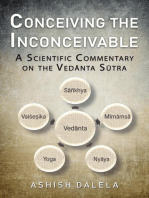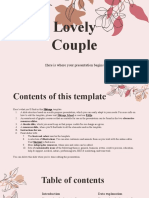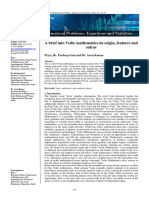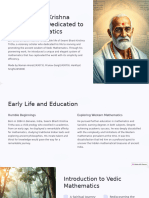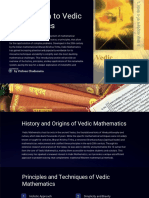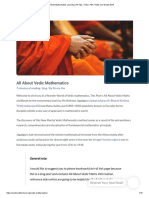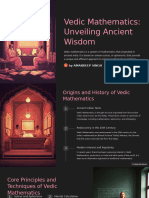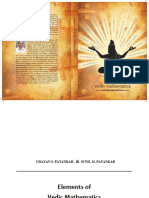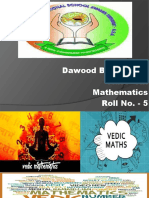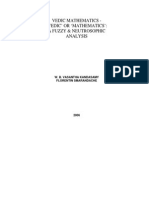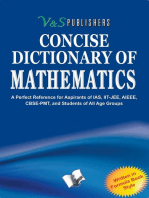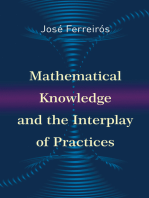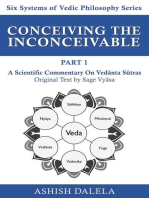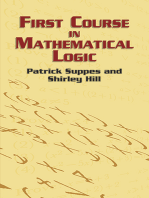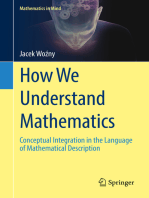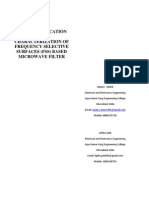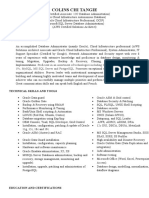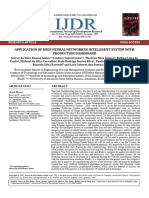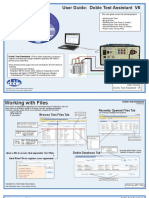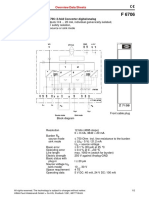A Thematic Analysis On Vedic Mathematics and Its I
A Thematic Analysis On Vedic Mathematics and Its I
Uploaded by
jefeena.21uma118Copyright:
Available Formats
A Thematic Analysis On Vedic Mathematics and Its I
A Thematic Analysis On Vedic Mathematics and Its I
Uploaded by
jefeena.21uma118Original Title
Copyright
Available Formats
Share this document
Did you find this document useful?
Is this content inappropriate?
Copyright:
Available Formats
A Thematic Analysis On Vedic Mathematics and Its I
A Thematic Analysis On Vedic Mathematics and Its I
Uploaded by
jefeena.21uma118Copyright:
Available Formats
Open Access Library Journal
2020, Volume 7, e6665
ISSN Online: 2333-9721
ISSN Print: 2333-9705
A Thematic Analysis on Vedic
Mathematics and Its
Importance
Sher Singh Raikhola1, Dinesh Panthi2*, Eka Ratna Acharya3, Kanhaiya Jha4
1
Department of Mathematics, Bhaktapur Multiple Campus, Tribhuvan University, Bhaktapur, Nepal
2
Department of Mathematics, Valmeeki Campus, Nepal Sanskrit University, Kathmandu, Nepal
3
Central Department of Education, Tribhuvan University, Kathmandu, Nepal
4
School of Science, Kathmandu University, Dhulikhel, Nepal
How to cite this paper: Raikhola, S.S., Abstract
Panthi, D., Acharya, E.R. and Jha, K. (2020)
A Thematic Analysis on Vedic Mathematics Vedic mathematics is found to be very effective and sound for mental calcula-
and Its Importance. Open Access Library tions in mathematics. Sutras and sub sutras have beautiful and striking tricks
Journal, 7: e6665. for fast and easy for mathematical calculations. In this article, we explore on
https://doi.org/10.4236/oalib.1106665
importance of Vedic Mathematics with thematic analysis. Vedic Math pro-
Received: July 26, 2020 vides more systematic, simplified, unified and faster than the conventional
Accepted: August 25, 2020 system. A significant and interesting invention which has led to various ap-
Published: August 28, 2020
plications in all the disciplines is the development of Vedic Math approach.
Copyright © 2020 by author(s) and Open
The importance of Vedic mathematics can be characterized as: 1) mathemat-
Access Library Inc. ical calculations, 2) speed, 3) classic approach, 4) fun and interesting, and 5)
This work is licensed under the Creative individual confidence.
Commons Attribution International
License (CC BY 4.0).
Subject Areas
http://creativecommons.org/licenses/by/4.0/
Open Access Numerical Mathematics
Keywords
Vedic Math, Mathematical Calculations, Classic Approach, Vedic Sutra,
NVivo 12 Pro, FFT
1. Introduction
The Sanskrit word “Veda” means knowledge. The word Veda literarily means
the fountain head and illimitable knowledge store. Therefore, the Veda contains
all knowledge that is essential for mankind. Veda is the original word for Vedic.
The word Veda also refers to the sacred ancient Hindu literature which is di-
DOI: 10.4236/oalib.1106665 Aug. 28, 2020 1 Open Access Library Journal
S. S. Raikhola et al.
vided into four parts: the Rig-Veda, the Yajur Veda, the Sam Veda and the
Atharva Veda. The Atharva Veda is sometimes called the “Veda of magical for-
mulae”. It is the primary source of information about Vedic culture. Subjects
covered in the Vedas include Grammar, Astronomy, Architecture, Psychology,
Philosophy, Economics, Medicine and Archery [1].
“Vedic Mathematics” is a very good technique or method of calculations
based on simple rule and principles. By this technique, any mathematical prob-
lem whether it is arithmetic or algebra or geometry or trigonometric can be
solved [2].
Vedic mathematics is an old technique that consists of sixteen sutras and thir-
teen sub sutras. It simplifies the fundamental arithmetic operations. It also solves
algebraic concepts like simultaneous equation, quadratic equations, factorization
of cubic equations etc. more effectively than the traditional approach. Vedic
Mathematics can speed up mathematical calculations such as Arithmetic, Alge-
bra, Trigonometry and Geometry. It reduces the time to solve a mathematical
problem and boosts the student confidence [3].
Vedic Mathematics works faster in areas of Trigonometry, Co-ordinate Geo-
metry and Calculus, in the same effective manner. It helps students in minimiz-
ing careless mistakes. It is simple and one-line approach. Moreover, it has an
inbuilt system of a series of checks. Medical research has proved that our brain
weight may increase by five percent if we do not have mental exercise and brain
weight once increased, cannot be reduced [4].
According to a study conducted some years ago, by a university in America,
the constant use of calculators for more than twenty years by a person atrophies
his brain significantly. Through Vedic Mathematics, we use both parts of our
brain, thereby, keeping us mentally fit [5].
Vedic mathematics is an old system of Mathematics. Vedic mathematics was
rediscovered early in early twentieth century by Sri Bharati Krishna Tirthji [6].
Vedic mathematics is known to be the ancient system in Indian mathematics
which was re-explored Vedas in 18th to 19th Century by Sri Bharati Krishna Tirtha-
ji. He developed sixteen sutras (formulae) and thirteen sub-sutras (sub-formula)
to understand the mathematics. In Sanskrit, the terms sutra means “Thread of
Knowledge”. In English, sutra means formula. Swami Bharati Krishna Tirthji
developed methods and techniques for amplifying the principles contained in
the aphorisms and their corollaries, and called it Vedic Mathematics [7].
Vedic mathematics [6] is useful for basic and complex mathematical opera-
tions. The methods provided in the book for basic mathematics are easy but po-
werful. Large calculation on division, multiplications, addition, and subtraction
can be performed easily by using Vedic tricks and formulae. Vedic Sutras and
tricks provide beautiful and striking methods that is systematic than modern
system of mathematics. Vedic mathematics provides the integrated structure of
mathematics that is complementary, direct and easy. The Vedic system allows
children to use these principles to simplify a math problem to a level that they
DOI: 10.4236/oalib.1106665 2 Open Access Library Journal
S. S. Raikhola et al.
can master and build their “Number Sense”. Calculating in Vedic Mathematics
is like playing mind game and results can be digging out very shortly like read-
ing words. The book provides varieties of sutras (formulas) to solve mathemati-
cal problems in a creative, interesting and intelligent way. It will support to take
advantage in mathematics and logic that help our children to excel in the class-
room and beyond [8]. It can induce creativity in intelligent pupils, while helping
slow-learners grasp the basic concepts of mathematics. A wider use of Vedic
math can undoubtedly generate interest in a subject that is generally dreaded by
children [9].
Vedic Mathematics [6] contains 16 formulas and 13 sub-formulas. These su-
tras are used in solving complex computations, and executing them manually.
The algorithms and principles are given in Urdhvatiryakbhyam sutra is used for
vertical and crosswise multiplication [10]. Vedic multiplier is based upon this
sutra. Array multiplication is its primary source. In the design and implementa-
tion of Triyakbhyam were done and the speed was compared with Nikhilam su-
tra, squaring and cubing algorithm [5].
2. Objectives and Methodology
Bajaj argued Vedic Mathematics allows increasing people’s confidence by ap-
plying Sutra to solve the mathematical problems [4]. It also suggested creativity
to calculate problems that is related to Vedic Mathematics. Agarwal, Matta and
Aryafound Vedic mathematics is an efficient algorithm for speedy calculations
of math problems [2]. So, in this regard, this study has been carried out to study
about the Vedic Mathematics and its importance in the mathematics. That is
why, the researchers showed interest to undertake this research. The qualitative
research aims to discover the meaning through the patterns of observed infor-
mation. It emerges after the keen observation, proper documentation and careful
analysis of the research topic. This study has set the objectives to find out the
importance of Vedic Math in the modern era to make a word cloud of Vedic
Mathematics.This study mainly focuses on Vedic Mathematics and its impor-
tance in modern era. In order to explore the importance of Vedic Mathematics,
the researcher has collected literature explaining the importance of Vedic ma-
thematics.
The researchers used thematic analysis approach to analyze the available lite-
ratures to highlight the major theme of contribution of Vedic mathematics in
the modern era. Researchers collected published works as its data and subjects
them to a careful analysis that usually includes qualitative aspects. NVivo 12 Pro
software is used for qualitative analysis for Thematic Analysis. World Cloud and
Cluster Analysis is made to show the major theme of Vedic Math’s importance
in the modern era. Thematic analysis through word cloud gives importance of
Vedic mathematics can be characterized as 1) mathematical calculations, 2)
speed, 3) classic approach, 4) fun and interesting, and 5) individual confidence.
Hence this is an exploratory study to generate theme.
DOI: 10.4236/oalib.1106665 3 Open Access Library Journal
S. S. Raikhola et al.
3. Definitions of Key Terms Used
NVivo—NVivo is a Qualitative data analysis (QDA) computer software
package produced Qualitative Research Software (QSR) International.
FFT—A fast Fourier transform (FFT) is an algorithm that computes the dis-
crete Fourier transform (DFT) of a sequence, or its inverse (IDFT). Fourier
analysis converts a signal from its original domain to a representation in the
frequency domain and vice versa.
Thematic Analysis—Actually, thematic analysis (TA) is a well-known me-
thod for analyzing, interpretating, and explaining data in various disciplines and
fields. It has several uses. It can be applied in distinct ways in distinct fields. It is
used to address lots of different research questions. It is one of the cluster of
methods that focus on identifying patterned meaning across a dataset.
TA is best thought of as an umbrella term for a set of approaches for analyzing
qualitative data that share a focus on identifying themes (patterns of meaning) in
qualitative data.
Cluster Analysis—Cluster analysis or clustering is the method of keeping a
set of objects together in such a way that objects in the same group known as
clusters are similar to each other than those from other groups. It’s a prime
function of exploratory data mining and a well-known technique for statistical
data analysis, used in many fields, including pattern recognition, image analysis,
information retrieval, bioinformatics, data compression, computer graphics and
machine learning.
4. Analysis
It is very important to learn and understand the basic concepts to make any cal-
culation easy. These two basic concepts-base and complement are the pillars of
Vedic Mathematics. These are explained below with examples.
4.1. Base
Bases are the numbers which start with 1 and ends with 0’s. For example 10, 100,
1000, 10000, 100000, and so on are called bases. The first 2-digit number is 10
and the first 3-digit number is 100 and so on. Only these kinds of numbers are
considered as bases. Numbers such as 200, 300, 450, 1500 are not considered as
bases.
4.2. Complement
When two numbers are added with each other and it results in the next nearest
base, then they are called Complements of each other.
For Example,
1) Consider the number 74. The next nearest base of 74 is 100. By adding 26
we will get 100. So 74 and 26 are complements to each other.
2) Consider the number 254. The next nearest base of 254 is 1000. By adding
746 we get 1000. So they are Complements to each other.
DOI: 10.4236/oalib.1106665 4 Open Access Library Journal
S. S. Raikhola et al.
3) Similarly, Complement of 3 is 7(Base is 10), Complement of 28 is 72 (Base
is 100), Complement of 6545 is 3455 (Base is 10000).
4.3. Ideas for Determination of Complement Number
Example: Subtract 3 5 8 7 3 2 from 1000000
To determine the Complement of a number can be calculated by subtracting
all numbers from 9 and the last number by 10, for example; complement of
358732 can be calculate as,
9 9 9 9 9 10 − 3 5 8 7 3 2 = 6 4 1 2 6 8
Or
9 9 9 9 9 10
↓ ↓ ↓ ↓ ↓ ↓
Subtract
3 5 8 7 3 2
= 6 4 1 2 6 8
The Formula is “All from 9 and the last from 10’’ [6]. Similarly, the Comple-
ment of 5183 can be calculate as,
9 9 9 10 − 5 1 8 3 = 4 8 1 7
4.4. Documents Analysis
Documents analysis also supports to thematic analysis. Documents are the relia-
ble sources of data. Vaidya concluded that in Vedic Math approach has time and
again proved to offer a huge advantage in preparation for these events as well as
for an individual’s holistic development [10]. It is useful in bringing back fun
and interest of students in an abstruse subject like Mathematics. A systematic
and developed study of Vedic Mathematics will be extremely useful for students
and researchers.
Acharya made efforts to connect classical and modern approach to change the
archetype in mathematics by focusing upon the indications of mathematical de-
velopments [1]. The author found applications of derivatives in solving quadrat-
ic equation and also explained the relation between the first order derivative and
factors of quadratic expression, cubic expression and bi-quadratic expression. By
giving examples, the author has also explained application of Vertical and
Crosswise Sutra for solving successive differentiation of the product of algebraic
and exponential functions and also for solving problems of Integration based on
Integration by parts. Writer concludes with the help of that evidences that in 100
years before the contents have not significantly changed but algorithm and the
method of solving problem has altered.
Agarwal, Matta, and Arya studied the scheme and method of FFT by applying
an efficient algorithm of Vedic Math which results being speedy and dependable
for calculating N-point Discrete Fourier Transform [2]. Authors have explained
how to reduce algorithm of 4 bit multiplication into 4 bit multiplication by giv-
ing an example by using Urdhva-Tiryagbhyam. They have also discussed about
the design of a particular FFT with the help of Vedic multiplier and adder. When
DOI: 10.4236/oalib.1106665 5 Open Access Library Journal
S. S. Raikhola et al.
compare to regular Fast Fourier transform, and Vedic FFT is more efficient in
term of time. A combination of FFT and Vedic Mathematics will create new de-
velopments in various fields.
Aggarwal investigated on observations from “Figuring” by Shakuntala Devi
and found Human computers’ like Shakuntala Devi do their mental calculations,
their shortcuts and tips are remarkably similar to the short cuts used in Vedic
Math’s secret steps [3].
Bajaj depicted that when one applies Sutra to certain questions requiring crea-
tivity and rationality, this enhances a person’s self-confidence [4]. The one thing
common among all math prodigies since 15th century is the desire to excel by
developing innovative methods to approach the given problem. In Vedic me-
thodology, solution to any given problem can be arrived at in two different
ways-one being the implementation of the general approach & the other one is
identifying the arrangement of variables and application of situation specific
formulas. As per his opinion, a significant and interesting invention which has
led to various applications in all the disciplines is the development of Vedic Ma-
thematics (VM) approach. This wide applicability can be explained by the quick
& insightful solutions obtained through basic minimum arithmetic procedure.
The author has tried to compare each Vedic Sutra with algebraic proof by pro-
viding sufficient examples.
4.5. Interpretation
Theme Generation: Available review of literature is processed through NVivo 12
Pro and theme is generated as show in Figure 1.
Figure 1 shows the major bold type face as calculating, Vedic, contents,
change, functions, individual, development, sutra, functions, disciplines, ex-
plained, mathematics, useful and so on. World Cloud generates themes as Vedic
math is algebraic functions which solve the given problems and builds the con-
fidence.
Cluster analysis is done through items clustered by word similarity. It is ex-
pressed in Figure 2.
Figure 2 shows that Vedic mathematics is clustered as mathematical calcula-
tions, speed, classic approach, fun and interest, and individual confidence. It is
said that Vedic math calculation creates fund and interest and faster calculates
the solution and increase individual confidence.
The Sutras apply to and cover almost every branch of Mathematics. They are
applied to solve complex problems that involve a large number of mathematical
operations. The proper application of sutra saves time and needs less effort in
solving the problem in comparison to formal methods. As the application of the
sutra is logical and rational, the solutions appear like magic. It’s a matter of sur-
prise to everyone. The computer computation is also based upon these underly-
ing principles. They provide good methods of calculations and proper ways of
thinking for their appropriate applications.
DOI: 10.4236/oalib.1106665 6 Open Access Library Journal
S. S. Raikhola et al.
Figure 1. Word cloud. Source: Output of NVIVO 12 Pro.
Figure 2. Cluster analysis. Source: Output of NVIVO 12 Pro.
This course on Vedic Mathematics aims to bring an integrated approach in
learning mathematics with curiosity of observations and inquisitiveness. It
avoids the monotony of applying traditional theories and working with them
mechanically. The given explanations make the process vivid to the inquisitive
learners. The logical proof of sutras eliminates the common misconceptions that
the sutras are jugglery. The proper applications of sutras have improved the
skills of computations of the learners significantly. It ensures both speed and
accuracy as it is strictly based upon the rational and logical reasoning.
The knowledge of such methods makes the teachers able to shape the stu-
dents’ mind properly and enhance their talent and creativity. Applications of su-
tras to specific problems are not possible without rational thinking. It helps to
sharpen intuition which is bottom line of the mastery of the mathematical ge-
niuses of the past and present like Aryabhatta, Bhaskaracharya, Srinivasa Ra-
manujan, etc.
This course helps to use the above stated sutra and sub-sutras in learning ma-
thematics at the secondary level in a way different from what is taught at
DOI: 10.4236/oalib.1106665 7 Open Access Library Journal
S. S. Raikhola et al.
present. The method has become very effective. The innovation in the presenta-
tion is the algebraic proof for every elucidation of the Sutra or the Sub-Sutra
concerned.
5. Results
• Vedic Math provides more systematic, simplified, unified & faster than the
conventional system.
• Vedic Math gives the flexibility, fun and immense satisfaction and converts a
tedious subject into a playful and blissful one which anyone can learn with
smiles.
• Vedic Math with its special features has the inbuilt potential to solve the
psychological problem of Mathematics anxiety.
• Vedic Math increases speed and accuracy. Mathematics, derived from the
Veda, provides one line, mental and super-fast methods along with quick
cross checking systems.
• Vedic mathematics provides the integrated structure of mathematics that is
complementary, direct and easy.
• A significant and interesting invention which has led to various applications
in all the disciplines is the development of Vedic mathematics approach.
6. Conclusions
Vedic Mathematics is easier to learn, faster to use and less prone to error than
conventional methods. Furthermore, the techniques of Vedic Mathematics not
only enable the students to solve specific mathematical problems: they also de-
velop creativity, logical thinking and intuition.
From the above study, we can conclude that modern teaching of one way cal-
culations are rigid and boring. Vedic Mathematics has general methods and also
many methods that apply for special cases. These calculations can often be car-
ried out independent of direction & orientation. Because of this flexibility, stu-
dents can use their own approach which promotes creativity and intuition. In
this rapidly changing world, flexibility and adaptability are indispensible for
success. By using Vedic Sutras, complicated and lengthy computations can be
solved with greater accuracy and lesser time as compared to calculations based
on conventional mathematics. Vedic Mathematics also improves memory and
creates greater mental alertness. The most significant quality of Vedic Mathe-
matics is its consistency. Because of this quality, it creates stress-free and enjoya-
ble environment. It inspires innovations. The beautiful coherence between
arithmetic and algebra is clearly visible in the Vedic system.
Acknowledgements
We would like to thank Dr. Shajeeb Kumar Shrestha, Associate Professor of
Management, of Tribhuvan University, Nepal for assistance with Cluster analy-
sis technique and methodology that greatly improved the manuscript.
DOI: 10.4236/oalib.1106665 8 Open Access Library Journal
S. S. Raikhola et al.
Conflicts of Interest
The authors declare no conflicts of interest regarding the publication of this pa-
per.
References
[1] Acharya, E.R. (2015) Mathematics Hundred Years Before and Now. History Re-
search, 3, 41-47. https://doi.org/10.11648/j.history.20150303.11
[2] Agarwal, J., Matta, V. and Arya, D. (2013) Design and Implementation of FFT Pro-
cessor Using Vedic Multiplier with High Throughput. International Journal of
Emerging Technology and Advanced Engineering, 3, 207-211.
[3] Aggrawal, S. (2013) Observations from Figuring. http://vedicmaths.org
[4] Bajaj, R. (2005) Vedic mathematics: The Problem Solver. Black Rose Publications.
[5] Bose, S. (2014) Vedic Mathematics. V and S Publishers, New Delhi, Edition 192.
[6] Tirthaji, S.B.K. (1965) Vedic Mathematics. Motilal Banarasidass, New Delhi.
[7] The Concept of Vedic Maths (2015)
https://www.walnutexcellence.com/the-concept-of-vedic-maths/
[8] William, K. (n.d.) How to Unleash Your Natural Ability for Mental Math by Dis-
covering the “Secret Mathematician” Hidden Deep within You!
http://www.mathmonkeybrunei.com/vedic_math.php
[9] Das, S. (n.d.) The History & Future of Vedic Maths.
http://hinduism.about.com/od/vedicmaths/a/vedicmath_history_future.htm
[10] Vaidya, S.A. (2019) The Contribution of Vedic Mathematics in Advance Calculus.
Doctoral Dissertation, Shri Jagdishprasad Jhabarmal Tibrewala University, Rajast-
han, India.
DOI: 10.4236/oalib.1106665 9 Open Access Library Journal
You might also like
- Online Food Ordering Website Is A Web Based Software That Helps To Order Food OnlineDocument29 pagesOnline Food Ordering Website Is A Web Based Software That Helps To Order Food OnlineujjalNo ratings yet
- Conceiving the Inconceivable: A Scientific Commentary on the Vedānta SūtraFrom EverandConceiving the Inconceivable: A Scientific Commentary on the Vedānta SūtraNo ratings yet
- GDPR Guidance On Employee Personal DataDocument7 pagesGDPR Guidance On Employee Personal DataMirsadaNo ratings yet
- Lovely Couple - by SlidesgoDocument52 pagesLovely Couple - by SlidesgoDrake IsaacNo ratings yet
- Vedic MathematicsDocument4 pagesVedic Mathematicst gNo ratings yet
- Vedic ReferenceDocument13 pagesVedic Referencejefeena.21uma118No ratings yet
- Vedic Maths IntroDocument3 pagesVedic Maths IntroSowmya SrinivasanNo ratings yet
- Adobe Scan 13 May 2023Document7 pagesAdobe Scan 13 May 2023dishikathakur04No ratings yet
- Swami-Bharti-Krishna-Tirtha-A-Life-Dedicated-to-Vedic-MathematicsDocument9 pagesSwami-Bharti-Krishna-Tirtha-A-Life-Dedicated-to-Vedic-MathematicsNaman AroraNo ratings yet
- Vedic MathsDocument3 pagesVedic Mathsaashank13singhNo ratings yet
- INTRODUCTIONDocument5 pagesINTRODUCTIONsenbrosNo ratings yet
- Vedic MathematicsDocument10 pagesVedic Mathematicskadiba6573No ratings yet
- Vedic Maths 4Document6 pagesVedic Maths 4saikiranNo ratings yet
- Introduction To Vedic MathematicsDocument8 pagesIntroduction To Vedic MathematicsExcel Edson ChibaNo ratings yet
- 25 Eng. V.K. Gupta 26Document16 pages25 Eng. V.K. Gupta 26navneetccnaNo ratings yet
- IJRSML 2019 Vol07 Issue 05 Eng 07Document6 pagesIJRSML 2019 Vol07 Issue 05 Eng 07navneetccnaNo ratings yet
- All About Vedic MathematicsDocument12 pagesAll About Vedic MathematicsVedic Math SchoolNo ratings yet
- MJIS BaradwajDocument12 pagesMJIS BaradwajSarghuna RaoNo ratings yet
- Vedic Mathematics Unveiling Ancient WisdomDocument8 pagesVedic Mathematics Unveiling Ancient WisdomAMANDEEP SINGHNo ratings yet
- GEN-746 FINAL - CopyDocument17 pagesGEN-746 FINAL - CopyRavi RaviNo ratings yet
- VedicMathematicsMannual27 11 2015 PDFDocument82 pagesVedicMathematicsMannual27 11 2015 PDFPhani Kumar100% (3)
- Complete History of Vedic Mathematics, Vedic Math SchoolDocument3 pagesComplete History of Vedic Mathematics, Vedic Math SchoolVedic Math SchoolNo ratings yet
- Elementi Vedic MatematikeDocument323 pagesElementi Vedic MatematikeDraganNo ratings yet
- Swami Bharati Krishna Tirthaji Maharaja: A Pioneer of Vedic MathematicsDocument13 pagesSwami Bharati Krishna Tirthaji Maharaja: A Pioneer of Vedic MathematicsJayesh GuptaNo ratings yet
- Dawood Bin Shabir Class - XII Mathematics Roll No. - 5Document17 pagesDawood Bin Shabir Class - XII Mathematics Roll No. - 5DawoodNo ratings yet
- Introduction Vedic MathematicsDocument3 pagesIntroduction Vedic MathematicsKaran TikooNo ratings yet
- Relevance of Vedic Mathematics in Enhancing Speed and AccuracyDocument12 pagesRelevance of Vedic Mathematics in Enhancing Speed and AccuracyGaurav Tekriwal100% (1)
- Vedic MathematicsDocument62 pagesVedic Mathematicskarmaa0% (1)
- Vedic MathematicsDocument4 pagesVedic MathematicsTeam shabdlessNo ratings yet
- Whay Vedic MathematicsDocument2 pagesWhay Vedic MathematicsshuklahouseNo ratings yet
- Vedic MathsDocument8 pagesVedic Maths2330219No ratings yet
- A New Branch of Mental Math Has Recently Been RevealedDocument1 pageA New Branch of Mental Math Has Recently Been RevealedMandingo StoneNo ratings yet
- Uses of Vedic Mathematics: Why You Should Know Vedic Maths?Document2 pagesUses of Vedic Mathematics: Why You Should Know Vedic Maths?VISHAL JALANNo ratings yet
- Vedic MathameticsDocument220 pagesVedic MathameticsDanielle WilliamsonNo ratings yet
- Vedic Mathematics Lesson PDFDocument140 pagesVedic Mathematics Lesson PDFLaki BGNo ratings yet
- Mathematical Concepts and Its Theories in The VedasDocument3 pagesMathematical Concepts and Its Theories in The VedasEditor IJTSRDNo ratings yet
- Ug B.ed. Education 70123 C - Teaching of Mathematics 9236Document277 pagesUg B.ed. Education 70123 C - Teaching of Mathematics 9236kv karinguNo ratings yet
- Vedic MathsDocument220 pagesVedic Mathstargettutorials5740100% (7)
- Conceiving the Inconceivable Part 1: A Scientific Commentary on Vedānta Sūtras: Six Systems of Vedic Philosophy, #1From EverandConceiving the Inconceivable Part 1: A Scientific Commentary on Vedānta Sūtras: Six Systems of Vedic Philosophy, #1No ratings yet
- Investigating the Psychological World: Scientific Method in the Behavioral SciencesFrom EverandInvestigating the Psychological World: Scientific Method in the Behavioral SciencesNo ratings yet
- Learning to Reason: An Introduction to Logic, Sets, and RelationsFrom EverandLearning to Reason: An Introduction to Logic, Sets, and RelationsRating: 4 out of 5 stars4/5 (2)
- How We Understand Mathematics: Conceptual Integration in the Language of Mathematical DescriptionFrom EverandHow We Understand Mathematics: Conceptual Integration in the Language of Mathematical DescriptionNo ratings yet
- The Skeleton Key of Mathematics: A Simple Account of Complex Algebraic TheoriesFrom EverandThe Skeleton Key of Mathematics: A Simple Account of Complex Algebraic TheoriesNo ratings yet
- Crosscutting Concepts: Strengthening Science and Engineering LearningFrom EverandCrosscutting Concepts: Strengthening Science and Engineering LearningNo ratings yet
- Functional Analysis: An Introduction to Banach Space TheoryFrom EverandFunctional Analysis: An Introduction to Banach Space TheoryNo ratings yet
- Discrete and Computational GeometryFrom EverandDiscrete and Computational GeometryRating: 4.5 out of 5 stars4.5/5 (3)
- Images of Mathematics Viewed Through Number, Algebra, and GeometryFrom EverandImages of Mathematics Viewed Through Number, Algebra, and GeometryNo ratings yet
- Design, Fabrication AND Characterization of Frequency Selective Surfaces (FSS) Based Microwave FilterDocument5 pagesDesign, Fabrication AND Characterization of Frequency Selective Surfaces (FSS) Based Microwave FilterAnjali OmerNo ratings yet
- RS85 V1.0 Catalog 171204 Spread LowDocument8 pagesRS85 V1.0 Catalog 171204 Spread LowEmrah SeverNo ratings yet
- Colins Chi Tangie: Professional SummaryDocument5 pagesColins Chi Tangie: Professional Summarykiran2710No ratings yet
- Network Security and Cyber SecurityDocument26 pagesNetwork Security and Cyber SecuritySattar KianiNo ratings yet
- Lexicon Mx400 ManualDocument60 pagesLexicon Mx400 ManualGuitar Coach MelbNo ratings yet
- MotoHawk Software PSDocument6 pagesMotoHawk Software PSCABean1No ratings yet
- Lecture 4Document21 pagesLecture 4Tuyizere Jean de DieuNo ratings yet
- Using Usb Secondary Isp Bootloader PDFDocument7 pagesUsing Usb Secondary Isp Bootloader PDFMainak SenNo ratings yet
- Command-Line Arguments in The C Language: R.C. Maher EE475 Fall 2004Document2 pagesCommand-Line Arguments in The C Language: R.C. Maher EE475 Fall 2004Abinash DeepakNo ratings yet
- Activity 1 English Culture MCE Team 2Document21 pagesActivity 1 English Culture MCE Team 2Diego HernandezNo ratings yet
- How To Create A ResumeDocument2 pagesHow To Create A ResumeMajkel Benche Custodio Mll100% (1)
- EE 411-Digital Signal Processing-Waqas MajeedDocument4 pagesEE 411-Digital Signal Processing-Waqas Majeedsalman_azmat_666No ratings yet
- Failure Modes, Effects, and Criticality Analysis (FMECA) : Dr. Shahul Hamid KhanDocument56 pagesFailure Modes, Effects, and Criticality Analysis (FMECA) : Dr. Shahul Hamid KhanYagna VeryNo ratings yet
- EK-RA6M4 - Evaluation Kit For RA6M4 MCU Group - RenesasDocument6 pagesEK-RA6M4 - Evaluation Kit For RA6M4 MCU Group - Renesaskeyboard2014No ratings yet
- Application of Deep Neural Network in Intelligent System With Production DashboardDocument12 pagesApplication of Deep Neural Network in Intelligent System With Production DashboardLuis GabryelNo ratings yet
- CS 601 Machine Learning Unit 3Document37 pagesCS 601 Machine Learning Unit 3Priyanka BhateleNo ratings yet
- AE4 MGT 1 01 Introduction To Management ScienceDocument23 pagesAE4 MGT 1 01 Introduction To Management ScienceRiane ValerioNo ratings yet
- CT-006-III 2020 Automatic Gravimetric Filling Instruments - OIML R 61-1 and 2 - Annex VIII MI-006 Chapter III LongDocument24 pagesCT-006-III 2020 Automatic Gravimetric Filling Instruments - OIML R 61-1 and 2 - Annex VIII MI-006 Chapter III LongIvelina AngelovaNo ratings yet
- Symantec™ Data Loss Prevention Administration GuideDocument1,472 pagesSymantec™ Data Loss Prevention Administration GuidemlevonNo ratings yet
- Power Supply Led Driver 715G5792P02004002H AOCDocument5 pagesPower Supply Led Driver 715G5792P02004002H AOCEgar EduardoNo ratings yet
- English Language Course Books PDF FreeDocument11 pagesEnglish Language Course Books PDF Freezoldyckhisoka56No ratings yet
- Powerware 5110 UPS Uninterruptible Power System: FeaturesDocument4 pagesPowerware 5110 UPS Uninterruptible Power System: Featuresandy175No ratings yet
- tds-100 Manual UltimoDocument81 pagestds-100 Manual UltimoCarlos Vilca JeriNo ratings yet
- DTA62 Quick User Guide EnglishRevB PDFDocument9 pagesDTA62 Quick User Guide EnglishRevB PDF322399mk7086No ratings yet
- Overview Data Sheets: F 6706: 2-Fold Converter Digital/analogDocument2 pagesOverview Data Sheets: F 6706: 2-Fold Converter Digital/analogmohamadziNo ratings yet
- Crome969 HeartwoodDocument8 pagesCrome969 HeartwoodAlcatrazz Albion OnlineNo ratings yet
- Original PDFDocument42 pagesOriginal PDFshradha11No ratings yet

